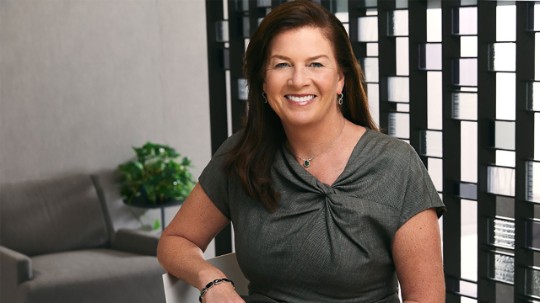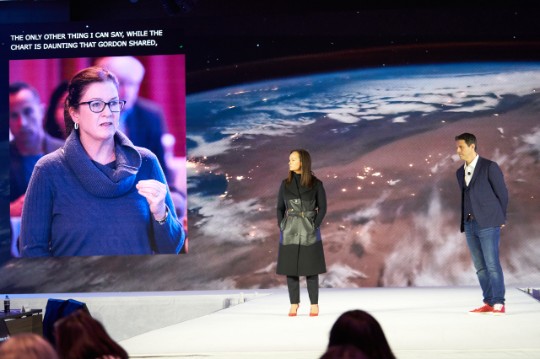An interview with Elizabeth Mily: How BMS is building broader growth now and beyond - Bristol Myers Squibb - Our stories

How BMS is building broader growth now and beyond
Bristol Myers Squibb’s growth has been driven by strategies that complement the company’s industry-leading R&D efforts with innovation that is sourced from outside the company. We spoke with former Executive Vice President, Strategy & Business Development, Elizabeth Mily in 2022, about the company’s approach to innovation, collaboration and growth.
Talk to us about the direction BMS is taking, and how you feel about it.
This is an incredibly exciting time for us. BMS is a leading global biopharma company that is focused on bringing forward truly transformational medicines for patients. We’re one of the largest R&D players globally, working at the center of the innovation ecosystem, with one of the largest R&D budgets in the world. We’ve launched nine new products across our portfolio in the past few years — three of them in 2022 alone.
As a company, we believe that this type of innovation can transform patient outcomes. That’s reflected in our focus on developing best-in-class and first-in-class medicines. In fact, five of the nine new medicines we launched are first-in-class.
Of course, business development (BD) is key to product development. We have expanded our BD activities across therapeutic areas, including equity investments, strategic collaborations, licensing agreements, and other deal structures. We are also actively monitoring the landscape for opportunities to pursue strategic mergers and acquisitions. We are especially interested in growing our business within the Asia Pacific market.
What’s the current state of BMS’ pipeline, and how does Business Development help grow our portfolio?
I would characterize our pipeline as deep and robust across all our therapeutic areas and modalities. We have six assets that are in or very close to registrational development, each of which has the potential to significantly benefit patients and support the long-term growth profile of the company. We’ve built a pipeline of over 50 Phase 1 and Phase 2 assets. We’ve also strengthened our external connections in academia and biotech to stay at the center of the innovation ecosystem, with over 300 ongoing collaborations, more than 80 of which are in early stage.
We also continue to advance our research programs in cell therapy and protein homeostasis, in addition to small molecules and complex biologics, and grow our digital portfolio, including AI and machine learning.
Business development complements our internal R&D efforts. Our end-to-end business development strategy strengthens our portfolio from discovery through late-stage development and commercial, enhancing the regenerative strength of our pipeline and addressing portfolio gaps.
What specific areas of business development is BMS focusing on at this point, and what challenges need to be overcome?
Our business development focus mirrors our core therapeutic areas — solid tumor oncology, hematology, cardiovascular disease, immunology — and, increasingly, expanding our foothold in neuroscience. In terms of overall strategy, we’re focusing on two main areas in our business development activities: the first is early-stage, science-based R&D collaborations that build our longer-term pipeline, and the second is strengthening our late-stage pipeline through acquisitions that enhance our commercial portfolio.
What differentiates our partnering approach is that we place ourselves at the center of the innovation ecosystem, and that we’re open to the full spectrum of partner companies and deal structures. A company may be in the process of raising Series A funding, or they may be in much later stages of development and seeking a development partner. We try to stay flexible and nimble in our approach. We also have a team that’s focused on ventures and early-stage investing, versus our business development teams that focus on therapeutic areas and technologies.
The challenges we face are those affecting any company that operates in a highly competitive global market and focuses on innovative assets. We’re determined to stay at the forefront of the most exciting developments, and to make sure we’re considered a partner of choice.
Elizabeth Mily
Former Executive Vice President, Strategy & Business Development

Let’s talk about Immunology first. What are BMS’ development goals in that area?
Thanks in part to Celgene’s legacy, we have an industry-leading pipeline in Immunology, with more than 20 programs across 20 diseases. Yet we see many segments where patient needs aren’t being met, in which there are tremendous opportunities to advance the standard of care. Our focus continues to be to prioritize assets that can either be first- or best-in-class in this field.
With respect to inflammatory diseases, we believe the next frontier will be therapies that restore immune tolerance. That’s a big priority for our R&D team, and also for our business development. In 2022, we signed an agreement with GentiBio to develop a regulatory T-cell (Treg) therapy aimed at treating inflammatory bowel disease (IBD). This collaboration pairs BMS’ expertise in cell therapy with GentiBio’s proprietary engineered platform for generating scalable, stable, selective and durable Tregs. We think it has the potential to bring significant benefits for patients with IBD.
What’s behind the additional investments in neuroscience?
We are committed to the development of transformational therapeutics for people with neurodegenerative and neuromuscular diseases, with a focus on areas of high unmet need in both common diseases (e.g., Alzheimer’s disease, multiple sclerosis and Parkinson’s disease) and rare diseases (e.g., ALS and Huntington’s disease). Our research focuses on breakthrough science where disease modification is the goal, including potential first- and best-in-class therapies that can prolong patient survival and meaningfully improve patient outcomes.
We have deep, existing expertise in Neuroscience, along with a strong network of external partnerships, which makes us well equipped to address neurological and neuromuscular diseases. Through the investments we’ve made across discovery and development, we have created a pipeline of potentially differentiated therapies across multiple treatment platforms (small molecules, biologics and nucleic acid targeting), building upon our leadership in protein homeostasis, immunology and inflammation.
Our mindset is very much agnostic in terms of modality. We are investigating ways in which different modalities may apply across different disease areas.
BMS is the only company with two CAR T therapies. At present, CAR T therapy can only be used for hematology. What’s your strategy for expanding the use of CAR T into the treatment of solid tumors?
It’s hugely important that we build on and advance our leadership in cell therapy, and that we progress to the next generation of treatments. We’re committed to expanding the application of CAR T beyond hematology. We’re also committed to making these technologies accessible to more patients — and that means finding ways to make them more cost-effective to manufacture.
The ultimate goal is to enable the applicability of cell therapy in many more disease areas, including solid tumors. Several approaches are being studied, but at this point it’s difficult to predict which ones will be successful. This is another area where strategic partnerships are crucial.
What kind of business development strategy is BMS pursuing for gene therapy and related approaches beyond oncology?
We’re interested in leveraging gene therapy and gene editing technologies wherever they can help patients. Within business development, a major part of our focus — together with our scientific partners — is to identify the most effective modalities for individual diseases and disease areas and develop future therapies. Right now, our primary emphasis is on gene therapy’s potential applicability in cardiovascular disease and diseases of the central nervous system. We think this approach will prove to be a game-changer in several therapeutic areas.
How do you envision the industry changing in the future? What are the biggest opportunities and challenges for the pharmaceutical industry?
As an industry, we see three major opportunities. First, the power of collaboration — over the past three years, we saw the power of collaboration in accelerating scientific breakthroughs; it’s important that we apply this to addressing the other urgent health challenges of our time. Second, digital transformation – the integration of AI and machine learning is speeding drug discovery and development, helping to decentralize clinical trials to address inequities and access, and extending access to care. Finally, a focus on health equity — doing our part to ensure that healthcare works for everyone and build health equity into our business models. I’m confident that BMS, and the industry as a whole, are up for the challenge of continuing to bring life-changing medicines to more patients in the years to come.